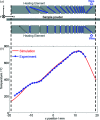A thermal-gradient approach to variable-temperature measurements resolved in space
- PMID: 32684881
- PMCID: PMC7312153
- DOI: 10.1107/S160057672000415X
A thermal-gradient approach to variable-temperature measurements resolved in space
Abstract
Temperature is a ubiquitous environmental variable used to explore materials structure, properties and reactivity. This article reports a new paradigm for variable-temperature measurements that varies the temperature continuously across a sample such that temperature is measured as a function of sample position and not time. The gradient approach offers advantages over conventional variable-temperature studies, in which temperature is scanned during a series measurement, in that it improves the efficiency with which a series of temperatures can be probed and it allows the sample evolution at multiple temperatures to be measured in parallel to resolve kinetic and thermodynamic effects. Applied to treat samples at a continuum of tem-peratures prior to measurements at ambient temperature, the gradient approach enables parametric studies of recovered systems, eliminating temperature-dependent structural and chemical variations to simplify interpretation of the data. The implementation of spatially resolved variable-temperature measurements presented here is based on a gradient-heater design that uses a 3D-printed ceramic template to guide the variable pitch of the wire in a resistively heated wire-wound heater element. The configuration of the gradient heater was refined on the basis of thermal modelling. Applications of the gradient heater to quantify thermal-expansion behaviour, to map metastable polymorphs recovered to ambient temperature, and to monitor the time- and temperature-dependent phase evolution in a complex solid-state reaction are demonstrated.
Keywords: X-ray scattering; negative thermal expansion; powder X-ray diffraction; sample environments; variable temperature.
© International Union of Crystallography 2020.
Figures



 or
or 
 . For the present gradient-heater configuration (shown in Fig. 2 ▸) a = 0.54, b = 44°C.
. For the present gradient-heater configuration (shown in Fig. 2 ▸) a = 0.54, b = 44°C.




 YMnO3 + LiCl (middle). The series of variable-temperature data can be described by five components (left), derived from an NMF analysis, with the weightings of the five components changing as a function of temperature, reflecting different states of the metathesis reaction (right). Conventional phase identification and Rietveld refinement applied to the NMF components (left) can identify the multiple phases that contribute to each NMF component and their relative abundance. For example, component A contains 23% t-YOCl, 22% LiMnO2, 7% r-YOCl, 13% Y3O4Cl, 6% Mn3O4, 12% LiMn2O4, 10% LiCl, 4% h-YMnO3 and 2% o-YMnO3.
YMnO3 + LiCl (middle). The series of variable-temperature data can be described by five components (left), derived from an NMF analysis, with the weightings of the five components changing as a function of temperature, reflecting different states of the metathesis reaction (right). Conventional phase identification and Rietveld refinement applied to the NMF components (left) can identify the multiple phases that contribute to each NMF component and their relative abundance. For example, component A contains 23% t-YOCl, 22% LiMnO2, 7% r-YOCl, 13% Y3O4Cl, 6% Mn3O4, 12% LiMn2O4, 10% LiCl, 4% h-YMnO3 and 2% o-YMnO3.
References
-
- Chapman, K. W., Chupas, P. J. & Kepert, C. J. (2005). J. Am. Chem. Soc. 127, 15630–15636. - PubMed
-
- Chapman, K. W., Lapidus, S. H. & Chupas, P. J. (2015). J. Appl. Cryst. 48, 1619–1626.
-
- Chupas, P. J., Chapman, K. W., Kurtz, C., Hanson, J. C., Lee, P. L. & Grey, C. P. (2008). J. Appl. Cryst. 41, 822–824.
-
- Coelho, A. A. (2018). J. Appl. Cryst. 51, 210–218.
LinkOut - more resources
Full Text Sources
